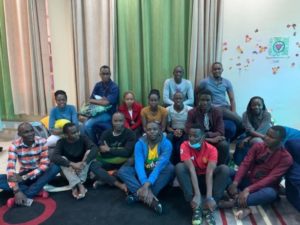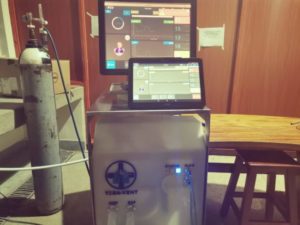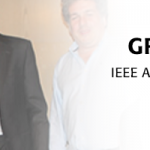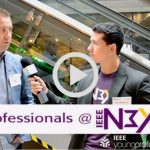Kenyatta University Students Innovate Ventilator in response to COVID-19
“Daring to dream big goes a long way. When there is a problem around you, looking for solutions within is more effective than looking for them without. In our case, we found the solution for the desolation in ourselves. It is crucial that we learn to believe in ourselves.”
Mercy Chelangat, Social Impact Liaison on the 2020 IEEE Entrepreneurship Steering Committee, interviewed the team lead, who provided his perspective on his experience working with a team towards innovative solutions geared towards solving the COVID-19 pandemic.
The INNOVATION…
Today we take a look at an emerging and vibrant Student Branch in Kenya that responded to the COVID-19 pandemic by building a mechanical ventilator. The ventilator assists patients who have breathing difficulties. I interviewed the team lead and the current IEEE Kenya Section Students’ Representative, Fidel Makatia, to get further insights on how they developed this.
How Does it Work?
The ventilator has two modes, IPPV and SIMV modes. The first mode offers mandatory breaths to patients who completely cannot breathe on their own. The second one assists patients that can breathe on their own but are not able to achieve volumes.
It alternates the spontaneous breaths and mandatory breaths. The machine has pressure sensors, flow sensors, and oxygen sensors to monitor and regulate the respective parameters based on settings.
 The ventilator also has a user interface(UI) used for settings and monitoring.
The ventilator also has a user interface(UI) used for settings and monitoring.
The UI can connect to multiple devices simultaneously and remotely.
This aids in preventing the spread of the disease in the instance a medical practitioner lacks personal protective equipment, as they can access remotely.
Similarly, this addresses the shortage of medics in the country.
The ventilator also has alarms that seek to protect the patient. For example, if the set pressure is not being achieved, an alarm is sounded.
It also has logs for all the critical alarms and information for the past 72hrs.
Motivation Behind the Innovation
The emergence of the COVID-19 pandemic came with a lot of turmoil.
Thus, my team and I sought to use our skills to bring hope to the desolate society. COVID-19 patients suffer from difficulty in breathing.
 Owing to the global pandemic, there was a shortage of ventilators. At the same time, the existing ones were very expensive. This ventilator would assist patients in breathing. Additionally, they are locally available and affordable.
Owing to the global pandemic, there was a shortage of ventilators. At the same time, the existing ones were very expensive. This ventilator would assist patients in breathing. Additionally, they are locally available and affordable.
Moreover, we would be aiding patients in breathing as well as easing the headache of the government on attaining ventilators.
The Team Behind the Innovation
Our team is consists of two electrical engineers, six biomedical engineers, three mechanical engineers, one civil engineer, a medical, a pharmacy student, and a nursing student. We are 15 in total. We are members of PES, Photonics, Comsoc, Signal Processing Society, Women in Engineering, and EMBS Society. Myself (team leader) I am the Kenya section student representative and the chair of Kenyatta University SB. Cynthia (one of the team members) is the chair for WIE Kenyatta University chapter.
Lessons Learned
The project aimed to come up with a locally available, affordable mechanical ventilator that would assist COVID-19 patients in breathing. We learned the following:
- Engineering is multidisciplinary. We could not have done it alone without the help of other engineering students in diverse fields, medical students, and our mentors. The importance of a team is undeniable. As a team, we complemented each other, got diverse perspectives, and got the job done.
- Daring to dream big goes a long way. When there is a problem around you, looking for solutions within is more effective than looking for them without. In our case, we found the solution for the desolation in ourselves. It is crucial that we learn to believe in ourselves.
The Mentor Team
Our Vice-chancellor, Prof. Paul Wainaina, Our dean, an Electrical Engineer (Dr. Shaddrack Mambo), Professor Nicholas Gikonyo a pharmacist, Dr. Gorgon Ogweno a medical doctor and professional anesthetist, Dr. Ken Iloka a Biomedical Engineer, Dr. June Madete a biomedical engineer, Dr. George Kosimbei an economist, Dr. John Alumasa a critical care nurse, Dr. George Magore a mechanical engineer, Dr. Thuita and industrial Pharmacist and Dr. Priscilla Kabue Dean school of nursing were some of our mentors.
All in all, mentors are people who make the journey to where you are going easier, as they have been there before. Ours is specialized in diverse fields. They advised us on the best means of achieving our goals more shortly and effectively. The team consisted of the users of the product and engineers who have worked with such a product before.
 Impact of the Ventilator
Impact of the Ventilator
The ventilator project has inspired more people to come up with solutions to solve the COVID-19 pandemic.
Furthermore, it has given a directive to the government to support local manufacturing industries.
It has also been a source of hope to Kenyans, seeing a solution is come from among their own. It has also made Kenyans have trust in their institutions of higher learning.






